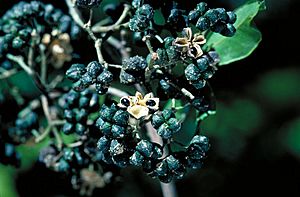Melicope jonesii facts for kids
Quick facts for kids Melicope jonesii |
|
|---|---|
 |
|
| Fruit | |
| Scientific classification | |
| Genus: |
Melicope
|
| Species: |
jonesii
|
Melicope jonesii is a type of tree found only in north-east Queensland, Australia. It belongs to the Rutaceae family, which also includes citrus trees like oranges and lemons. This tree has special leaves with three parts, and its flowers are greenish or cream-colored. These flowers grow in small clusters near the leaves.
Contents
About the Melicope Jonesii Tree
Melicope jonesii is a tall tree that can grow up to 35 meters (about 115 feet) high. Its leaves grow in pairs on opposite sides of the stem. Each leaf is "trifoliate," meaning it has three smaller leaflets. These leaflets are shaped like ovals. They can be between 100 and 175 millimeters (4 to 7 inches) long.
Flowers and Fruit
The flowers of Melicope jonesii are small and grow in clusters called panicles. These clusters are usually 20 to 35 millimeters (about 1 inch) long. The flowers are "bisexual," meaning each flower has both male and female parts. They have four small, round sepals (leaf-like parts at the base of the flower) and four greenish or cream-colored petals. Each flower also has four stamens, which are the male parts that produce pollen.
This tree usually flowers in January and February. After flowering, it produces fruit. The fruit is made of up to four small pods, called follicles. Each pod is about 8 to 10 millimeters (0.3 to 0.4 inches) long. These pods are joined at the bottom and contain shiny black seeds.
Naming the Melicope Jonesii Tree
The scientific name Melicope jonesii was first officially described in 2001. This was done by a botanist named Thomas Gordon Hartley. He wrote about it in a science journal called Allertonia. The tree was named jonesii to honor another botanist, William T. Jones (1908–1970).
Where Melicope Jonesii Grows
This special melicope tree lives in rainforests. It grows at high altitudes, usually between 720 and 1000 meters (about 2,360 to 3,280 feet) above sea level. You can find it in areas from near the Daintree National Park all the way to the Ella Bay National Park in Queensland.
Conservation Status
The Queensland Government has looked at Melicope jonesii. They have classified it as a species of "least concern." This means that it is not currently considered to be in danger of disappearing. This classification is under the Queensland Government's Nature Conservation Act 1992.

